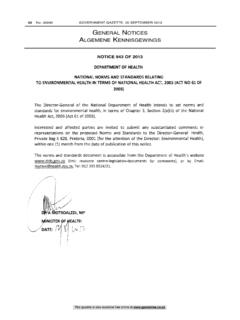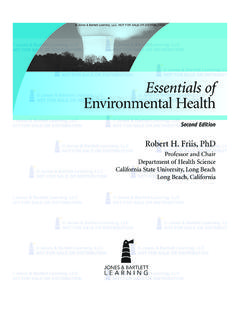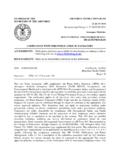Transcription of Executive summary World Health Organization …
1 Executive summary World Health Organization Model List of essential In Vitro Diagnostics First edition (2018) Report of the first Strategic Advisory Group on In Vitro Diagnostics (SAGE-IVD) WHO headquarters, Geneva, 16 20 April 2018 1 Contents Executive summary .. 2 Recommendations of the Strategic Advisory Group of Experts on In Vitro Diagnostics (SAGE-IVD) .. 4 List of participants .. 5 Declaration of interests .. 7 Annex 1: WHO Model List of essential In Vitro Diagnostics, first edition .. 8 Preface .. 8 List of essential In Vitro Diagnostics (EDL) .. 15 I List of essential In Vitro Diagnostics (EDL): For primary Health care .. 15 II List of essential In Vitro Diagnostics (EDL): For Health care facilities with clinical laboratories 21 2 Executive summary Access to good quality, affordable, and appropriate Health products is indispensable to advance universal Health coverage, address Health emergencies, and promote healthier populations the three strategic priorities of the World Health Organization (WHO) Thirteenth General Programme of Work 2019 access to In vitro diagnostics (IVDs), Health providers cannot diagnose patients effectively and promptly or provide appropriate treatments.
2 In March 2017, the WHO Expert Committee on Selection and Use of essential Medicines recommended the development of a Model List of essential In Vitro Diagnostics (EDL), to complement the WHO Model List of essential Medicines (EML). To support the EDL and to advise on other in vitro diagnostic initiatives, WHO created a Strategic Advisory Group of Experts on In Vitro Diagnostics (SAGE-IVD). The SAGE-IVD, which includes 19 multidisciplinary members with global representation, held its first meeting from 16 20 April 2018 at WHO headquarters, Geneva. The SAGE IVD made recommendations for the content, format and implementation of the first edition of the EDL. It is foreseen that EDL will be an important tool in increasing access to appropriate, affordable and quality-assured IVDs, particularly where they are most needed to address Health priorities.
3 Scope and selection of IVDs for inclusion in the first edition of the EDL The EDL focusses on IVDs, a subset of medical devices intended for the in vitro examination of specimens derived from the human body, solely or principally to provide information for diagnostic, monitoring or compatibility purposes. The WHO developed a draft EDL, which was posted on the WHO website and sent to relevant external stakeholders for comment. The draft list, with the comments received, was provided to the SAGE-IVD members at their meeting for their review and recommendations. The SAGE IVD confirmed a list of general IVD tests that should be available in primary Health care settings, and in hospitals and reference laboratories, for routine patient care. The information to select the general diagnostic tests was compiled from existing WHO guidance, guidelines, technical manuals and the priority medical devices lists.
4 The disease-specific IVDs were selected from WHO evidence-based guidelines, information from the WHO Prequalification of In Vitro Diagnostics Programme (PQ), or from other WHO IVD assessment processes. EDL content and format The first edition of the EDL consists of: 58 general laboratory tests that can be used for routine patient care and for the detection and diagnosis of a wide array of diseases communicable and noncommunicable, in the disciplines of clinical chemistry, blood transfusion, serology, microbiology, mycology, 1 WHO (2018). Thirteenth General Programme of Work 2019 2023 ( ). 3 parasitology and haematology. These tests support routine diagnosis and monitoring of many conditions such as diabetes, cardiovascular, anaemia, liver function. 55 types of laboratory tests needed for the detection, diagnosis and monitoring of HIV, tuberculosis, malaria, hepatitis B and C, syphilis and human papilloma virus.
5 For each category of test, the EDL specifies: test category and purpose; assay format; specimen type; and, Health care facility level for most appropriate use ( primary care with no or minimal laboratories versus facilities with laboratories). Links to WHO guidelines or publications and, when available, to prequalification or endorsed products. The EDL refers to tests according to their biological targets and does not use brand names. EDL intended audience and use The EDL is not prescriptive; rather it is expected that the EDL will provide guidance and serve as a reference to Member States and other parties involved in developing and/or updating lists of national essential IVDs and/or medical devices, and selecting and implementing such IVDs. While the EDL provides a list of important tests required at various levels of the Health system, ranging from primary Health care to reference hospital and laboratories, it is important to note that the EDL alone cannot have an impact.
6 It requires an integrated, connected, tiered laboratory system, with adequate human resources, training, laboratory infrastructure, and regulatory and quality assurance systems. Impact also requires Member States to adopt and adapt the EDL, to develop national or regional EDLs, and to implement the supply mechanisms necessary to ensure access to the required IVDs. In order to effectively use the EDL and adapt it to national needs, Member States will need to consider a variety of factors, including local demographics and burden of disease; treatment facilities; access to reagents and basic infrastructure; training and experience of available personnel; local and unmet testing gaps; supply chain and transport links; facility quality assurance coverage and capacity; local availability of treatments; financial resources; information technology capabilities; local disease elimination priorities; and environmental factors.
7 To that end, information that supports the selection and use of the IVDs on the EDL, and links to relevant WHO clinical guidelines, lists of prequalified IVDs and IVDs recommended by WHO disease control departments, and other relevant resources, will be consolidated on the WHO website together with the EDL. This compendium of materials is intended to support country uptake and facilitate implementation. Next steps The EDL will be updated annually. WHO will issue a call for applications to add IVD test categories to the next edition of the EDL in mid-2018. The first EDL will be expanded significantly over the next few years, incorporating other important areas such as antimicrobial resistance, additional noncommunicable diseases (NCDs), emerging pathogens, emergencies and outbreaks, and neglected tropical diseases. WHO acknowledges the technical input from all SAGE-IVD members, and the comments from stakeholders, and thanks the Department for International Development, United Kingdom, for providing a grant to support this process.
8 4 Recommendations of the Strategic Advisory Group of Experts on In Vitro Diagnostics (SAGE-IVD) Background The Strategic Advisory Group of Experts on In Vitro Diagnostics (SAGE-IVD): Welcomed the creation of SAGE-IVD by WHO to act as an advisory body with respect to matters of global policies and strategies related to IVDs. Supports WHO s focus on universal Health coverage, to ensure that all people have access to a full spectrum of essential , quality Health services, including diagnostics. essential medicines require essential diagnostics, and SAGE-IVD applauds WHO for the decision to create a WHO Model List of essential In Vitro Diagnostics (EDL), to complement the EML, which has been a very successful public Health strategy in enhancing access to medicines. Recommendations Recognizing the importance of tests for a wide variety of diseases, SAGE-IVD reviewed and agreed on a proposal for the first EDL, which should include a broad list of basic laboratory tests, as well as tests for the following initial set of diseases pursuant to WHO policy and for which there is high quality guidance: HIV, TB, malaria, HBV/HCV, and HPV and syphilis infections.
9 Consider the following tests be included in future editions of the EDL: antimicrobial resistance, neglected tropical diseases, NCDs, outbreaks/emergencies and sepsis. Include a detailed preface to the EDL to explain the objectives, limitations and guidance for its use. The preface should include: the scope of the EDL; a definition of the Health service levels referred to; the rationale for the contents; and stress the need to adapt the list to local or regional settings and conditions (one size does not fit all). Emphasize that while the EDL provides a list of important tests required at various levels of the Health system, the list itself cannot have an impact without an integrated, connected, tiered laboratory system, with adequate human resources, training, laboratory infrastructure, regulatory and quality assurance systems. Member States can adapt the EDL and develop national or regional EDLs, as well as implement the mechanisms necessary to ensure impact.
10 Revise and update various WHO technical documents that constitute a resource for EDL to make them relevant and current. This task should be prioritized, and if need be, supported by WHO collaborating centres, other institutions and SAGE-IVD. Support EDL via a dedicated web page that harmonizes all IVDs information available on the WHO website. Review and acknowledge that the WHO prequalification process plays an important role in increasing access to IVDs of assured quality, safety and performance. SAGE-IVD appreciates that 5 EDL and the WHO Prequalification of In Vitro Diagnostics Programme (PQ) are complementary processes in improving access to IVDs for Member States. List of participants SAGE-IVD members George Araj, Professor and Director of Clinical Microbiology, Department of Pathology and Laboratory Medicine, American University of Beirut Medical Center, Lebanon.
















